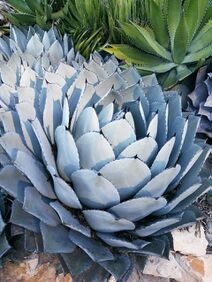Agave parryi
| Agave parryi | |
 | |
| Light: | |
| Moisture: | |
| Hardiness: | 8 |
| Soil pH: | 5.6-8.4 |
| Evergreen | |
| Height: | 2' |
| Width: | 3' |
| Native to: | |
| Edible Rating: | |
| Medicinal Rating: | |
| Tea: | Yes |
Agave parryi (common name: century plant)
Propagation: Seed - surface sow in a light position, April in a warm greenhouse. The seed usually germinates in 1 - 3 months at 20°c[1]. Prick out the seedlings into individual pots of well-drained soil when they are large enough to handle and grow them on in a sunny position in the greenhouse until they are at least 20cm tall. Plant out in late spring or early summer, after the last expected frosts, and give some protection from the cold for at least their first few winters[K].
Offsets can be potted up at any time they are available. Keep in a warm greenhouse until they are well established[2].
Cultivation: Requires a very well-drained soil and a sunny position[3][2].
This species is probably the hardiest member of the genus, it survives outdoors grown against a warm wall at Kew[4].
A monocarpic species, the plant lives for a number of years without flowering but dies once it does flower. However, it normally produces plenty of suckers during its life and these take about 10 - 15 years in a warm climate, considerably longer in colder ones, before flowering[4].
This plant is widely used by the native people in its wild habitat, it has a wide range of uses.
Members of this genus are rarely if ever troubled by browsing deer[5].
Range: South-western N. America - Arizona to New Mexico.
Habitat: Semi-arid land, 1300 - 2400 metres, often experiencing snow in winter with temperatures as low as -18°c for short periods[6].
Edibility: The heart of the plant is very rich in saccharine matter and can be eaten when baked[7][8]. Sweet and nutritious, but rather fibrous[9]. It is partly below ground[10].
Seed - ground into a flour and used as a thickener in soups or used with cereal flours when making bread[11].
Young flower stalk - raw or cooked[12]. It was generally roasted[13][14].
Tender young leaves - roasted[15].
Sap from the cut flowering stems is used as a syrup[13]. Nectar from the flowering stems is made into a sweet syrup[14]. The sap can also be tapped by boring a hole into the middle of the plant at the base of the flowering stem[9]. It can be fermented into 'Mescal', a very potent alcoholic drink[9].
Medicinal: The sap is antiseptic, diuretic and laxative[16].
Usage: The leaves contain saponins and an extract of them can be used as a soap[7]. It is best obtained by chopping up the leaves and then simmering them in water - do not boil for too long or this will start to break down the saponins[K].
A very strong fibre obtained from the leaves is used for making rope, coarse fabrics etc[7][17][11]. A paper can also be made from the fibre in the leaves[7].
The thorns on the leaves are used as pins and needles[7].
The dried flowering stems are used as a waterproof thatch[7] and as a razor strop.[18]
Pollinators: Moths, bats
Soil: Can grow in light and medium soils.
Drainage: Prefers well drained soil.
In Leaf: Evergreen
Flower Type: Hermaphrodite
Known Hazards: The plants have a very sharp and tough spine at the tip of each leaf. They need to be carefully sited in the garden.
Links
References
- ↑ Rice, Graham. Growing from Seed Volume 1. Thompson and Morgan, 1987.
- ↑ 2.0 2.1 Huxley, Anthony. The New Royal Horticultural Society Dictionary of Gardening. MacMillan Press, 1992.
- ↑ Chittendon, Fred. RHS Dictionary of Plants. Oxford University Press, 1951.
- ↑ 4.0 4.1 Bean, William. Trees and Shrubs Hardy in Great Britain. Murray, 1981.
- ↑ Thomas, Graham. Perennial Garden Plants. J. M. Dent & Sons, 1990.
- ↑ Pesman, M. Meet Flora Mexicana. Dale S King, 1962.
- ↑ 7.0 7.1 7.2 7.3 7.4 7.5 Hedrick, Ulysses. Sturtevant's Edible Plants of the World. Dover Publications, 1972.
- ↑ Tanaka, Tyōzaburō. Tanaka's Cyclopaedia of Edible Plants of the World. Keigaku Publishing, 1976.
- ↑ 9.0 9.1 9.2 Weiner, Michael. Earth Medicine, Earth Food. Ballantine Books, 1980.
- ↑ Harrington, Harold. Edible Native Plants of the Rocky Mountains. University of New Mexico Press, 1967.
- ↑ 11.0 11.1 Balls, Edward. Early Uses of Californian Plants. University of California Press, 1975.
- ↑ Moerman, Daniel. Native American Ethnobotany. Timber Press, 1998.
- ↑ 13.0 13.1 Kunkel, Günther. Plants for Human Consumption. Koeltz Scientific Books, 1984.
- ↑ 14.0 14.1 Facciola, Stephen. Cornucopia - A Source Book of Edible Plants. Kampong Publications, 1990.
- ↑ Yanovsky, Elias. Food Plants of the North American Indians Publication 237. US Department of Agriculture.
- ↑ Lust, John. The Herb Book. Bantam Books, 1983.
- ↑ Usher, George. A Dictionary of Plants Used by Man. Constable, 1974.
- ↑ Polunin, Oleg. Flowers of the Mediterranean. Hogarth Press, 1987.